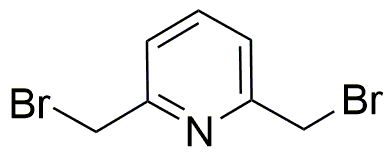2,6-Bis(bromomethyl)pyridine is widely utilized in research focused on:
- Synthesis of Pharmaceuticals: This compound serves as an important intermediate in the synthesis of various pharmaceutical agents, particularly those targeting neurological disorders.
- Polymer Chemistry: It is used in the development of specialty polymers, enhancing properties such as thermal stability and chemical resistance, making it valuable in the manufacturing of high-performance materials.
- Organic Synthesis: Researchers employ this compound in organic synthesis processes, particularly in the creation of complex organic molecules, due to its reactivity and ability to introduce bromomethyl groups.
- Bioconjugation: Its functional groups allow for effective bioconjugation techniques, which are essential in creating targeted drug delivery systems and diagnostic agents in biomedicine.
- Research in Material Science: The compound is explored in the field of material science for developing new coatings and adhesives that require enhanced adhesion properties and durability.
General Information
Properties
Safety and Regulations
Applications
2,6-Bis(bromomethyl)pyridine is widely utilized in research focused on:
- Synthesis of Pharmaceuticals: This compound serves as an important intermediate in the synthesis of various pharmaceutical agents, particularly those targeting neurological disorders.
- Polymer Chemistry: It is used in the development of specialty polymers, enhancing properties such as thermal stability and chemical resistance, making it valuable in the manufacturing of high-performance materials.
- Organic Synthesis: Researchers employ this compound in organic synthesis processes, particularly in the creation of complex organic molecules, due to its reactivity and ability to introduce bromomethyl groups.
- Bioconjugation: Its functional groups allow for effective bioconjugation techniques, which are essential in creating targeted drug delivery systems and diagnostic agents in biomedicine.
- Research in Material Science: The compound is explored in the field of material science for developing new coatings and adhesives that require enhanced adhesion properties and durability.
Documents
Safety Data Sheets (SDS)
The SDS provides comprehensive safety information on handling, storage, and disposal of the product.
Product Specification (PS)
The PS provides a comprehensive breakdown of the product’s properties, including chemical composition, physical state, purity, and storage requirements. It also details acceptable quality ranges and the product's intended applications.
Certificates of Analysis (COA)
Search for Certificates of Analysis (COA) by entering the products Lot Number. Lot and Batch Numbers can be found on a product’s label following the words ‘Lot’ or ‘Batch’.
Numéro de catalogue
Numéro de lot/série
Certificates Of Origin (COO)
This COO confirms the country where the product was manufactured, and also details the materials and components used in it and whether it is derived from natural, synthetic, or other specific sources. This certificate may be required for customs, trade, and regulatory compliance.
Numéro de catalogue
Numéro de lot/série
Safety Data Sheets (SDS)
The SDS provides comprehensive safety information on handling, storage, and disposal of the product.
DownloadProduct Specification (PS)
The PS provides a comprehensive breakdown of the product’s properties, including chemical composition, physical state, purity, and storage requirements. It also details acceptable quality ranges and the product's intended applications.
DownloadCertificates of Analysis (COA)
Search for Certificates of Analysis (COA) by entering the products Lot Number. Lot and Batch Numbers can be found on a product’s label following the words ‘Lot’ or ‘Batch’.
Numéro de catalogue
Numéro de lot/série
Certificates Of Origin (COO)
This COO confirms the country where the product was manufactured, and also details the materials and components used in it and whether it is derived from natural, synthetic, or other specific sources. This certificate may be required for customs, trade, and regulatory compliance.

